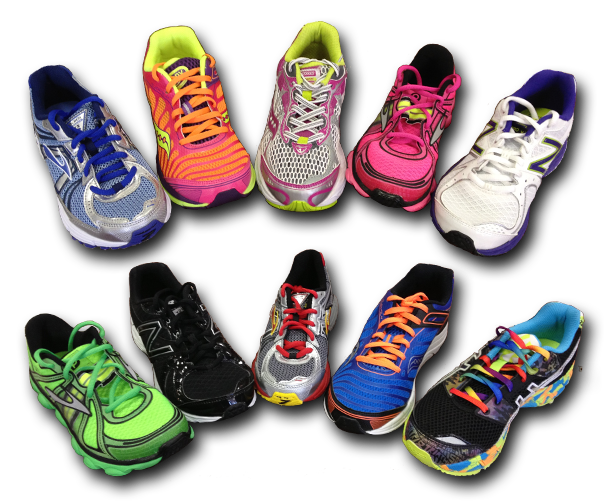Do you know how to choose the right running shoe for YOU?
As everyone has different needs when it comes to choosing a running shoe. There are many factors that may ned to be taken into consideration – your biomechanics, weight, running surfaces, and of course the actual shape of your feet.
Running shoes are categorised into 3 main groups – cushioned, stability ,and motion control – generally categorisd by your biomechanics;
and 3 minor groups – performance training, racing ,and off-road – more specialised and considered often as second shoes.
The following is only concerned with the 3 main groups.
A good starting point is to use the Wet Test – basically that the shape ofs your wet footprint on a dry floor or piece of paper roughly correlates with the amount of stability you might need in your shoe.
Main Groups
The Normal Foot
Normal feet have a normal-sized arch and leaves a wet footprint With a flare, but showing the forefoot and heel connected by a broad band. A normal foot landson the outside of the heel and rolls inwards slightly to absorb shock.
It’s the foot of a runner who is biomechanically efficient and therefore doesn’t need a motion control shoe.
Best shoes– Stability shoes* with moderate control features.
The Flat Foot
This has a low arch and leaves a print which looks like the whole sole of the foot. It usually indicates an overpronated foot – one that strikes on the outside of the heel and rolls inwards (pronates) excessively. Overtime this can cause many different types of overuse injuries.
Best shoes – Motion control shoes *or high stability ones with firm mmidsoles and control features that reduce the degree of pronation. Stay away from highly cushioned, highly curved shoes, which lack stability features.#
The High Arched Foot
This leaves a print showing a very narrow band or no band at all between the forefoot and the heel. A curved, highly arched foot is generally supinated or underpronated. As it doesn’t pronate enough, it’s not usually an effective shock absorber.
Best shoes – cushioned *, or neutral, ones with plenty of flexibility to encourage foot motion. Stay away from motion control or stability shoes which reduce foot mobility.
*Explanations of terms:
Stability shoes – offer a good blend of cushioning, medial support (to limit excessive inward rolling of the foot, which can cause injury) and durability. T provide stability, they often have a medial post or dual-density midsole – features which provide a firmer density under the inner edge of the foot. Usually build on a semicurved last.
Buy these if – you’re a midweight runner with no severe motion control problems and want a shoe wIth some medial support and good durability. Runners with normal arches are often fine in stability shoes.
Motion control shoes – the most rigid, control-oriented shoes. Designed to slow down or limit extreme inward rolling of the foot and ankle, which can cause injury (overpronation). Generally heavy but very durable. May include features such as a medial post under the inner edge of your foot for pronation control, a polyurethane midsole for midsole durability and a carbon rubber outsole for outside durability. Many built on a straight last which offers stability and maximum support on the inner side of your foot.
Buy these if – you are an overpronator who needs control features and good durability, or you wear orthoses (sculpted shoe inserts) and wants a firm midsole, deep heel counter, or a heavy runner who needs extra durability and control. Runners with flat feet often do best in motion control shoes.
Cushioned shoes – these generally have the softest midsole and the least added stability. They’re usually built on a semicurved or curved last to encourage foot motion which is helpful for runners who have rigid, immobile feet (underpronators)
Buy these if – you’re an efficient runner whose feet don’t roll inwards excessively (overpronate) when you run. Runners with high arches often do best in cushioned shoes.

